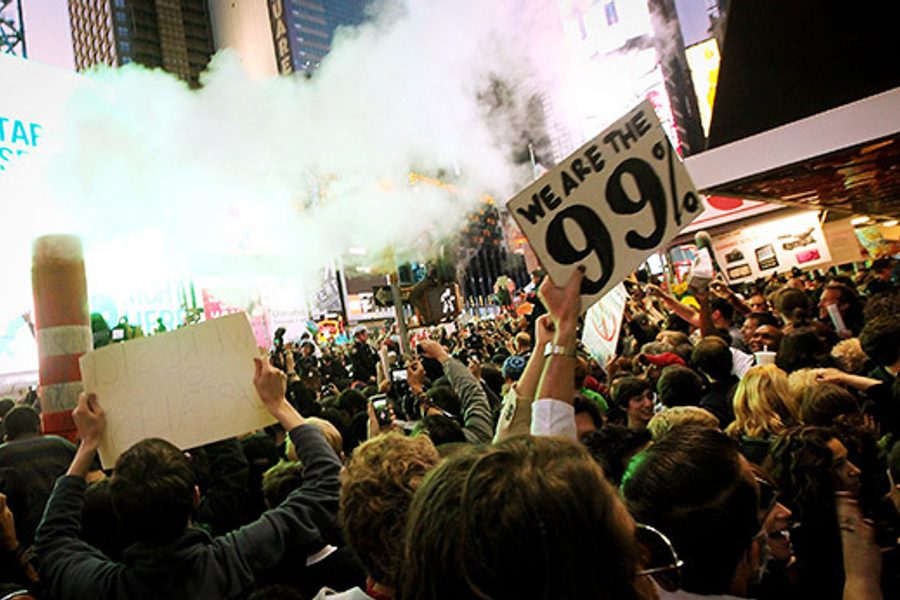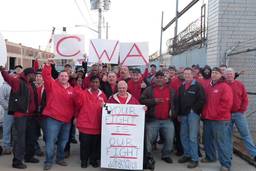“I feel like Wisconsin was the prologue, but this could be the first chapter. With Occupy Wall Street we are finally seeing the beginning of how to rebuild the labor movement,” says 97-year-old labor journalist Harry Kelber, who covered the labor movement in the 1930s.
Many in labor are hoping that the energy of the Occupy movement will re-invigorate their movement, which today represents only 6.9 percent of private-sector workers. It’s not entirely clear, however, how protests in public spaces will create an increased sense of solidarity – and hunger for a union contract – in the private space of the workplace, where bosses are able to fire at-will workers who attempt to organize unions.
Fiercely anti-union companies are clearly adept at undermining organizing campaigns. But many people in the labor movement say there is a lot more unions could be doing to successfully organize in a hostile climate. In the end, the Occupy movement may benefit the labor movement most not by building solidarity in the street, but by forcing labor leaders to rethink their strategy for rebuilding the labor movement. Unions’ ability to take full advantage of the Occupy movement will hinge on its ability to embrace social movements, be willing to take bold actions in smart strategic campaigns, to stick with those campaigns over the long run and to reform themselves to look and operate more like the Occupy protests.
In the past, the labor movement has had trouble fully embracing movements it did not control, says Dorian Warren, a Columbia University political science professor.
“Unions have different functions than social movements,” Warren says. “You see this with unions’ campaign contributions and scripted rallies. However, when you disrupt things and raise fundamental questions about society or the system, you have an ability to attract people and become more powerful. When unions speak, it’s often about a specific set of union members to which most people do not belong, and the rhetoric quickly starts to sound like ‘us versus them’ instead of the 99% movement.”
Labor has had a difficult time being co-partners with social movements. A prime example of this is website launched by the AFL-CIO’s Building Trades Council, which depicts environmental activists opposed to the Keystone Pipeline as “Hollywood’s elite 1%.” On other issues such as reproductive justice or racial justice, the labor movement has sometimes remained silent or narrow-minded in its focus.
“Look at Hurricane Katrina. Had the labor movement challenged publicly the policy of racism about how the schools were being reopened and what neighborhoods people were allowed to move back into, and not gone just to get the contract to rebuild, they could have really changed the dynamics in the South,” Cornell Professor Kate Bronfenbrenner says. “Yes, they would have alienated some members, but they would have gotten legs in the crowd in terms of organizing more in the south.”
The Occupy movement is at its core about taking action – occupying public space to make demands visible – and that attracts some people. But unions have often been hesitant about taking bold action.
“It’s just fascinating that the Occupy folks captured the mood of the nation, while many of us have spent years unsuccessfully trying to make this happen,” says Stephen Lerner, a member of SEIU’s executive board who called for mass direct action against financial institutions earlier this year in forums including In These Times’ May 2011 issue. “We can come up with messages and slogans that the majority of people agree with, but if it doesn’t make people want to get out of their seat and do something, then the message doesn’t work.
“The idea of 99% versus 1%, combined with people willing to risk arrest, adds a seriousness that brings the words to life,” says Lerner. “This may be the moment where the labor movement and other progressives finally break out of the Stockholm syndrome, which has trapped us into thinking we can only succeed by being sympathetic to and appealing to our captors – giant corporations.”
While in the past labor has shied away from movements that used civil disobedience (unless unions directly controlled them), AFL-CIO President Richard Trumka was quick to endorse OWS in early October, although he and other leaders are clearly being careful not to co-opt the movement in its infancy – or appear to. “We need to have people in the street right now,” Trumka told In These Times, explaining his endorsement. “Occupy Wall Street is an organic movement. We should support it and not try to control it. We have to understand their organic structure and respond to it.” AFL-CIO support has been very tangible for protesters: The labor federation allowed people occupying K Street to use showers in its D.C. headquarters.
But how exactly labor support for Occupy Wall Street will translate into support for organized labor is unclear.
“If people try to narrow this and put their specific issue at the top of the agenda, it’s not going to work. The opportunity is to build on what is already there. In Chicago, The Teachers Union has a concrete set of proposals that go to how Wall Street is bankrupting public services and public education – it moved people because it fits naturally with everyone’s experience on the ground,” says Lerner. “I think you are going to see an explosion of activity as people connect the damage Wall Street has done nationally to local struggles.”
Labor has helped integrate itself into the fabric of the Occupy movement through spontaneous, often uncoordinated actions. Already some OWS protests are naturally drifting into labor struggles, with OWS marching to support locked-out Sotheby art handlers (members of the Teamsters) and marching on Verizon Headquarters in support of 45,000 workers – members of the Communication Workers of America (CWA) and International Brotherhood of Electrical Workers attempting to bargain a contract.
“A good organizing drive is led from the inside out. Similarly, Occupy is organized by individuals banding together to make a statement and hopefully propose a campaign. As in organizing, CWAers will help support these campaigns, but we realize we need more people organizing,” CWA President Larry Cohen says. “When OWS and Verizon union members march together from Wall Street to West Street (Verizon HQ), it is an awesome sight and an example of how we can build a movement with a concrete focus and city-wide organizing.”
But Peter Olney, organizing director for the International Longshore and Warehouse Union, warns that exciting new alliances and broad critiques of the economic and political status quo won’t save labor. “If [the Occupy movement] goes on and continues to grows, it will give more confidence to people when they try to organize on the shop floor,” Olney says. “Occupy Wall Street is certainly going to have an impact. But it’s not a replacement for organizing that is community-based and predicated on long-term commitment, rather than quick and easy alliances.”
He continues:
The gains of the labor movement in the 1930s were the product of 20 to 30 years of organizing by socialists and ethnic organizations, and strike skirmishes. Occupy Wall Street is a great moment. It’s not a panacea for change; we’ve got to be about the long haul. … Organizing right now is characterized by great ideas, fancy power points, one-year investment and then moving on to grand scheme. It works for professional organizers, but it doesn’t work for actually organizing workers. We just had a struggle at Rite Aid warehouse in Lancaster, California where it took us five years to get a contract for 500 workers. And five years is considered a short struggle to what some in the hotel industry go through.
Part of the success of the 99% movement has hinged on its ability to allow the activists running the show to feel a sense of control over their social movement. That may be a tough lesson for the labor movement, which often struggles to cede control to the rank-and-file.
Another issue is that union leaders often come from different racial, and, increasingly, economic backgrounds (or are a different gender) than many members. “There is no question leaders that are living in a completely different world than world of their unions. As my research shows, the majority of new workers over the last 20 years being organized are women and people of color,” says Cornell’s Bronfenbrenner. “However, the leadership and the lead organizers are still white men making very high salaries. [They have] no connection to the world and lifestyle of the workers that they are organizing.”
Indeed, over the last 10 years the number of union officials making more than $100,000 a year has tripled as labor’s ranks have declined dramatically. The high salaries have turned unions away from being what former United Electrical workers union Director of Organization James Matles described – when justifying his unions decisions to cap staff salaries – as “an organization where your workers feel like members and not for the members.”
For labor movement observers like Columbia’s Warren, the big question is whether the labor movement can rebuild itself to not only capture the energy of the Occupy movement, but to actually look – in structure and governance – more like it.
“The big lesson is how a democratic process leads people to … their commitment to the organization and the effort,” Warren says. “If it was an effort that was driven by hierarchical structures and had a strong charismatic leader like Van Jones and his Rebuild the American Dream movement, it wouldn’t have attracted so many people.”
A shorter version of this story appeared in In These Times’ December 2011 issue.










